Bifurcations of a Ratio-Dependent Holling-Tanner System with Refuge and Constant Harvesting
Abstract
The bifurcation properties of a predator prey system with refuge and constant harvesting are investigated. The number of the equilibria and the properties of the system will change due to refuge and harvesting, which leads to the occurrence of several kinds bifurcation phenomena, for example, the saddle-node bifurcation, Bogdanov-Takens bifurcation, Hopf bifurcation, backward bifurcation, separatrix connecting a saddle-node and a saddle bifurcation and heteroclinic bifurcation, and so forth. Our main results reveal much richer dynamics of the system compared to the system with no refuge and harvesting.
1. Introduction
Generally speaking, from the views of the optimal management and exploitation of bioeconomic resources, it is necessary and meaningful to consider the refuge or harvesting of populations in some bioeconomic models; one can see [2–11], and the references therein.
For simplicity, we first rescale the system (2).
From the view of biology, we are only interested in the dynamics of the system (4) in the first quadrant.
The organization of this paper is as follows. In Section 2, we discuss the existence and properties of the equilibria of system (4). In Section 3, all possible bifurcation phenomena of the model in terms of the five parameters are presented, and the numerical simulations about every bifurcation phenomena are exhibited.
2. Qualitative Analysis of Equilibria
Obviously, Δ0 ≥ 0 if 0 < h ≤ 1/4 and Δ0 < 0 if h > 1/4.
Hence, (5) has two distinct positive solutions , if 0 < m < 1/2, m(1 − m) < h < 1/4, a positive solution x01 if 0 < m < 1,0 < h < m(1 − m), a double solution if 0 < m < 1/2, h = 1/4, and a solution x03 = 1 − 2m when h = m(1 − m) and 0 < m < 1/2.
The positive equilibrium P3 = (x3, y3) (P* = (x*, y*)) of system (4) exists if 0 < m < (1/2)(1 − β/(aβ + 1)), and h = m(1 − m)(0 < m < (1/2)(1 − β/(aβ + 1)), h = (1/4)(β/(aβ+1)−1)2 + mβ/(aβ + 1)), where x3 = 1 − 2m − β/(aβ + 1), y3 = βx3, x* = −(1/2)(β/(aβ + 1) + 2m − 1), and y* = βx*.
Summarizing the previous discussion, the number and location of equilibria of system (4) can be described by the following lemmas.
Lemma 1. Let 1/2 ≤ m < 1.
Lemma 2. Let 0 < (1/2)(1 − β/(aβ + 1)) ≤ m < 1/2.
- (i)
System (4) has no equilibria when h > 1/4.
- (ii)
System (4) has a unique equilibrium when h = 1/4.
- (iii)
System (4) has two equilibria E1 = (x01, 0) and E2 = (x02, 0) when m(1 − m) < h < 1/4.
- (iv)
System (4) has an equilibrium E3 = (x03, 0) when h = m(1 − m).
- (v)
System (4) has two equilibria E1 and P1 when 0 < h < m(1 − m).
Lemma 3. Let 0 < m < (1/2)(1 − β/(aβ + 1)) and .
- (i)
System (4) has no equilibria when h > 1/4.
- (ii)
System (4) has a unique equilibrium when h = 1/4.
- (iii)
System (4) has two equilibria E1 and E2 when .
- (iv)
System (4) has three equilibria E1, E2, and P* when .
- (v)
System (4) has four equilibria E1, E2, P1, and P2 when .
- (vi)
System (4) has two equilibria E1 and P1 when 0 < h < m(1 − m).
- (vii)
System (4) has two equilibria E3 and P3 when h = m(1 − m).
Hence, is a saddle node.
The previous discussion can be summarized as follows.
Theorem 4. If the equilibria E1, E2, and E3 exist, then E1 and E3 are hyperbolic saddle, and E2 is a hyperbolic unstable node. Moreover, E1 and E2 merge into a saddle node when h = 1/4.
Remark 5. Note that if h = 1/4, then , if h > 1/4, then . Thus, the prey species may go extinct as time increases for some initial values when h ≥ 1/4. That is, biological over harvesting occurs.
In the following, we will discuss the properties of interior equilibria of system (4).
2.1. The Properties of Interior Equilibria
If is a node if δ > δ2, and a degenerate node if δ = δ2, and a focus or a center-type nonhyperbolic if 0 < δ < δ2.
To discuss the stability of P1, we need to determine the sign of A1. Define , then .
Clearly, if then A1 > 0 for all δ; if , then A1 > 0 when , A1 ≤ 0 when by simple computation, one can obtain , hence .
Through the previous discussion, about the stability of P1 and P2, we have the following theorem.
Theorem 6. Equilibrium P2, if exists, must be a hyperbolic saddle. Equilibrium P1, if exists, may be a node or a focus when . And when , P1 is a stable focus for , a stable degenerate node for δ = δ2, a stable node for δ > δ2, an unstable node for 0 < δ < δ1, an unstable degenerate node for δ = δ1, an unstable focus for , and a weak focus or a center for .
Theorem 7. Let h = m(1 − m), . Then,
- (i)
assume 0 < m ≤ (1/2)(1 − β/(1 + aβ) − β/(1+aβ)2), then P3 is stable;
- (ii)
assume (1/2)(1 − β/(1 + aβ) − β/(1+aβ)2 ) < m < (1/2)(1 − β/(1 + aβ)), then P3 is stable if , is unstable if , and is a weak focus or a center if .
Theorem 8. Let 0 < m < (1/2)(1 − β/(aβ + 1)), . Then system (4) has three equilibria, where E1 is a hyperbolic saddle, E2 is a hyperbolic unstable node, and P* is a degenerate singularity. More precisely,
-
1° if δ ≠ 1/(aβ+1)2, then P* is a saddle node;
-
2° if δ = 1/(aβ+1)2, then P* is a cusp of codimension 2.
Proof. In order to discuss the properties of system (4) in the neighborhood of the equilibrium P* = (x*, y*), we first take , , then P* is translated to (0,0), and system (4) becomes (still denote , as x, y)
When δ = 1/(aβ+1)2 , , which implies that both eigenvalues of the matrix are zero. We rewrite system (20) as
By introducing variable τ = (β/(aβ+1)2 )t into previous system and rewriting τ as t for simplicity, then we obtain that
We take transformation X0 = x, Y0 = x − (1/β)y into (24), then system (24) is transformed to
Firstly, performing the transformation by taking X1 = X0, , then (26) becomes
Secondly, performing the transformation by taking X2 = X1, Y2 = Y1 + η5X1Y1, then (28) becomes
3. Bifurcation Analysis
From previous analysis, we can see the equilibria of system (4) may be hyperbolic or degenerate singularities under appropriate conditions, which indicate that some bifurcations may occur for system (4). It is interesting to investigate what kinds of bifurcations system (4) can undergo with the original parameters varying.
3.1. Hopf Bifurcation
Hence, when the parameter (a, m, β, δ, h) is in Hb (Hp), the equilibrium P1 of system (4) is a weak focus of multiplicity 1 and is unstable (stable) (see [8]). Hb (Hp) is called the subcritical (supercritical) Hopf bifurcation surface of system (4).
From Theorem 6, we know that P1 is a stable focus for and (a, m, β, δ, h) ∈ V, an unstable focus for and (a, m, β, δ, h) ∈ V.
Theorem 9. (i) System (4) has at least one unstable limit cycle if (a, m, β, δ, h) ∈ Hb, , .
(ii) System (4) has at least one stable limit cycle if (a, m, β, δ, h) ∈ Hp, , .
Remark 10. When σ = 0 system (4) maybe undergoes degenerate Hopf bifurcation for some parameter values; since the expression of σ is complicated, we do not discuss this case.
By numerical calculation, we give the parameter values (a, β, m, h) = (1.6, 2.0, 0.13095, 0.128), then , δ2 = 0.2220 and k1σ = 0.31085 > 0, and the existence condition of subcritical Hopf bifurcation is satisfied. If we keep a, β, m, h fixed and choose δ = 0.00249, then a unstable limit cycle can be shown in Figure 1(a).
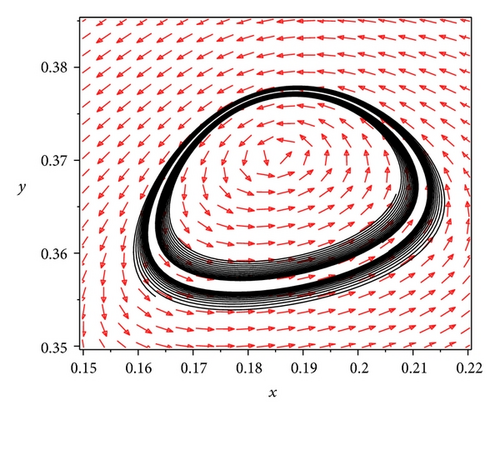
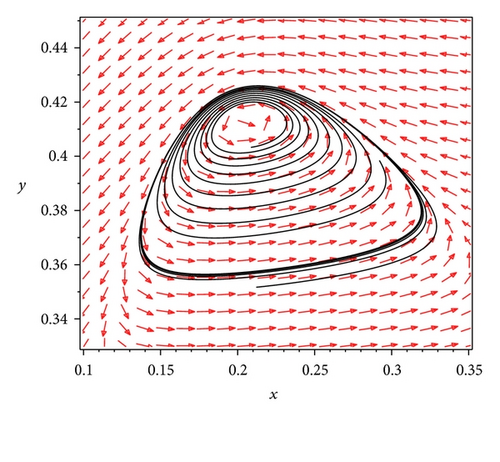
When taking (a, β, m, h) = (1.2, 2.0, 0.08235, 0.08396), then , δ1 = 0.0000391, and k1σ = −0.1741543 < 0 which satisfy the existence condition of supercritical Hopf bifurcation. Furthermore, we choose δ = 0.002919; according to Theorem 9, there exists a stable limit cycle, which can be shown in Figure 1(b).
3.2. Backward Bifurcation
Define .
Lemmas 2–3 and Theorems 6–8 illustrate that when the parameter h varies in the range of (0, m(1 − m)], system (4) just has only one positive equilibrium P1 which is stable. However, when h varies in the range , system (4) has two distinct positive equilibria P1 and P2, where P1 is a stable node or focus and P2 is a saddle. Furthermore, when , system (4) has unique positive equilibrium P*. The previous discussion indicates the possibility of a backward bifurcation, which can be summarized as follows.
Theorem 11. Let 0 < m < (1/2)(1 − β/(aβ + 1)), δ > δ2. Then system (4) has a unique positive equilibrium P* when R = R*, has two distinct positive equilibria P1 and P2 when R* < R < 1, where P1 is a stable node and P2 is a saddle, and has one positive equilibrium P1 or P3 when R ≥ 1. Therefore, system (4) undergoes a backward bifurcation when R = 1.
We give a numerical example in Figure 2 which displays that system (4) has a backward bifurcation at R = 1.
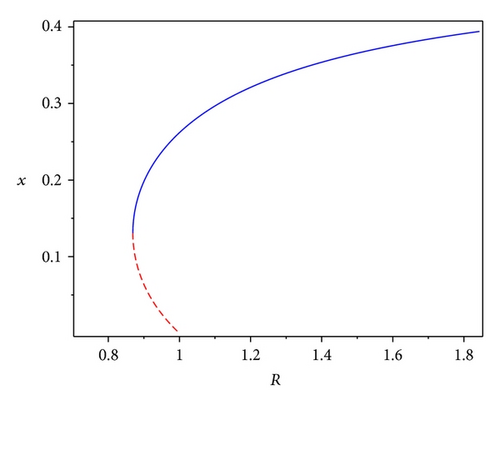
3.3. Saddle-Node Bifurcations
Similarly, from Lemma 3 and the part 1° of Theorem 8, we know that when 0 < m < (1/2)(1 − β/(aβ + 1)) and , in , system (4) admits the double point P* = (x*, y*). And P* is a saddle node if δ ≠ 1/(aβ + 1) 2.
3.4. Bogdanov-Takens Bifurcation
To show that system (4) undergoes the Bogdanov-Takens bifurcation we choose δ and β as bifurcation, parameters. We need to find the universal unfolding of P*.
Then system (4) exists the following bifurcation curves in a small neighborhood of the origin in the (μ1, μ2) plane.
Theorem 12. Let 0 < m < 1/2 − β/2(aβ + 1), δ = 1/(aβ+1)2, h = (1/4)(β/(aβ+1)−1)2 + mβ/(aβ + 1). Then system (43) admits the following bifurcations:
- (i)
there exists a saddle node bifurcation curve ;
- (ii)
there is a Hopf bifurcation curve H = {(μ1, μ2) : ε1 = 0 + o(∥μ∥) 2, ε2 < 0};
- (iii)
there is a homoclinic bifurcation curve .
The biological interpretation for the Bogdanov-Takens bifurcation is that if the harvesting rate h and the prey refuge value m satisfy 0 < m < 1/2 − β/2(aβ + 1) , h = (1/4)(β/(aβ+1)−1)2 + mβ/(aβ + 1), and δ = 1/(aβ+1)2, then the predator and prey coexist in the form of a positive equilibrium or a periodic orbit for different initial values, respectively. And there exist other values of parameters, such that the predator and prey coexist in the form of a positive equilibrium for all initial values lying inside the homoclinic loop, and the predator and prey coexist in the form of a periodic orbit with infinite period for all initial values on the homoclinic loop. By choosing β = 2, a = 1.6, m = (1/4)(1 − β/(aβ + 1)), h = (1/4)(β/(aβ+1)−1)2 + mβ/(aβ + 1), and δ = 1/(aβ+1)2, the numerical simulations for the Bogdanov-Takens bifurcation in Theorem 12 can be shown in Figures 3, 4 and 5.
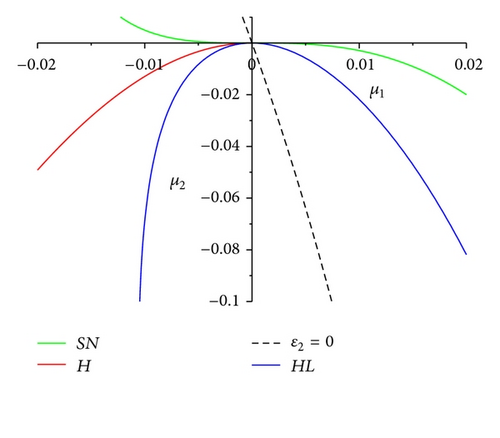
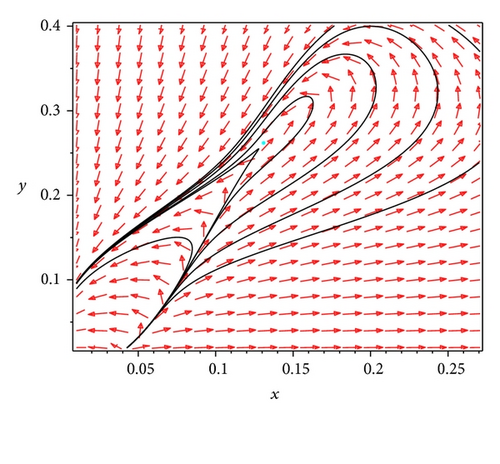
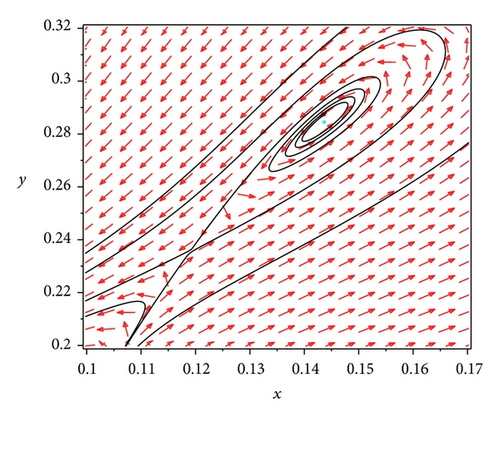
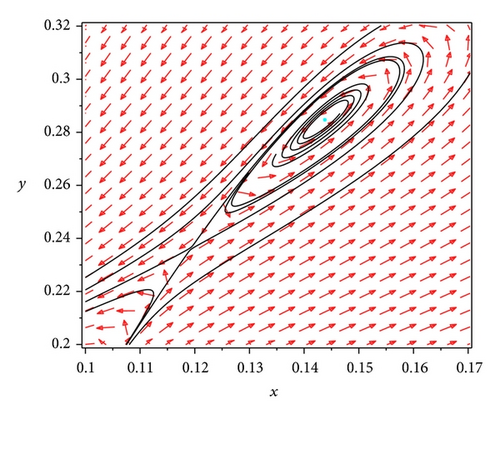
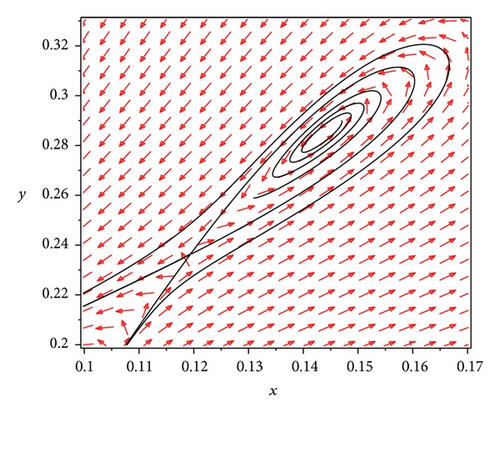
3.5. Separatrix Connecting a Saddle-Node and a Saddle Bifurcation and Heteroclinic Bifurcation
From Theorem 8 and Lemma 3, when 0 < m < (1/2)(1 − β/(aβ + 1)), , δ ≠ 1/(aβ + 1) 2, there may exist a separatrix connecting the saddle-node P* and the saddle E1. When 0 < m < (1/2)(1 − β/(aβ + 1)), , the saddle node P* separates into the hyperbolic node P1 and the hyperbolic saddle P2, which implies that system (4) undergoes a separatrix connecting a saddle node and a saddle bifurcation. Furthermore, the heteroclinic bifurcation may occur if there exists a heteroclinic orbit connecting the separatrix of saddle E1 and saddle P2.
Acknowledgments
This paper is supported by NSFC (11226142), Foundation of Henan Educational Committee (2012A110012), Foundation of Henan Normal University (2011QK04, 2012PL03), Natural Science Foundation of Shanghai (12ZR1421600), and Shanghai Municipal Educational Committee (10YZ74).




